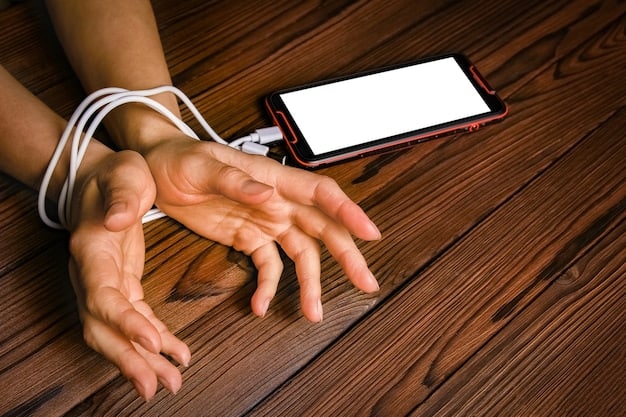Reclaim Your Zen: 3 Steps to Cut Smartphone Use by 50%

Is your smartphone stealing your zen? It’s a common question in our hyper-connected world. Discover three practical steps to reduce your screen time by 50%, reclaim your inner peace, and foster a more mindful existence.
In today’s always-on world, it’s easy to feel like your smartphone is running your life. Is your smartphone stealing your zen? The constant notifications, endless scrolling, and addictive apps can leave you feeling stressed, anxious, and disconnected from the present moment. Fortunately, there are concrete steps you can take to regain control and achieve a healthier, more balanced relationship with technology.
Is Your Smartphone Stealing Your Inner Peace?
Smartphones have become an indispensable part of modern life, offering unparalleled convenience and connectivity. However, this constant access comes at a cost: our mental and emotional well-being. It’s crucial to recognize the impact of excessive smartphone use on our ability to find inner peace and develop strategies to mitigate its negative effects.
The allure of instant gratification and the fear of missing out (FOMO) can create a cycle of dependence, where we constantly check our phones for updates, notifications, and validation. This constant stimulation overloads our senses and leaves us feeling drained and disconnected from the present moment.
The Impact on Mindfulness
Mindfulness involves paying attention to the present moment without judgment. Excessive smartphone use disrupts this practice by constantly pulling our attention towards digital distractions. When we’re constantly checking our phones, we’re not fully present in our interactions, experiences, or even our own thoughts.
The Link to Anxiety and Stress
Studies have shown a significant correlation between excessive smartphone use and increased levels of anxiety and stress. The constant barrage of information, the pressure to stay connected, and the fear of missing out can all contribute to a heightened state of anxiety. Moreover, the blue light emitted from screens can disrupt our sleep patterns, further exacerbating stress levels.

Ultimately, recognizing the detrimental effects of smartphone overuse on our mental well-being is the first step toward reclaiming our zen. By understanding how these devices impact our mindfulness and contribute to stress and anxiety, we can begin to implement strategies to reduce screen time and cultivate a more balanced and peaceful existence.
Step 1: Track and Understand Your Screen Time
Before you can effectively reduce your smartphone use, you need to understand your current habits. Tracking your screen time provides valuable insights into how much time you’re actually spending on your phone and which apps are consuming the most of your attention. This awareness is crucial for identifying areas where you can make meaningful changes.
Most smartphones come equipped with built-in tools that track screen time and app usage. These tools provide detailed reports on how much time you’re spending on your phone each day, which apps you’re using the most, and how frequently you’re checking your phone.
Using Built-In Tracking Tools
Both iOS and Android devices offer built-in screen time tracking features. On iOS, you can find Screen Time in the Settings app. On Android, look for Digital Wellbeing in the Settings menu. These tools allow you to set daily time limits for specific apps, receive notifications when you’re approaching your limits, and track your progress over time.
Identifying Time-Consuming Apps
Once you start tracking your screen time, pay close attention to which apps are consuming the most of your attention. Social media apps, games, and streaming services are often the biggest culprits. Identifying these time-consuming apps is essential for developing strategies to reduce your usage.
- Social Media Monitoring: Track the amount of time spent on platforms like Instagram, Facebook, and Twitter.
- Gaming Habits Analysis: Monitor how many hours are dedicated to mobile games.
- Streaming Services Overview: Assess the usage of video and music streaming applications.
By meticulously tracking your screen time, you gain a comprehensive understanding of your smartphone usage patterns. This awareness empowers you to make informed decisions about how to reduce your screen time and reclaim your zen.
Step 2: Set Realistic Limits and Boundaries
Setting realistic limits and boundaries is a crucial step in reducing your smartphone use and reclaiming your zen. It’s important to establish clear guidelines for when, where, and how you use your phone to prevent it from taking over your life. These limits should be sustainable and tailored to your individual needs and lifestyle.
Start by identifying times of day when you’re most vulnerable to excessive smartphone use. This might be first thing in the morning, during lunch breaks, or before bed. Once you’ve identified these periods, set specific limits for how long you’ll allow yourself to use your phone during these times.
Utilizing App Timers and Restrictions
Both iOS and Android offer features that allow you to set daily time limits for individual apps. This can be a powerful tool for curbing your use of time-consuming apps. When you reach your daily limit, the app will be temporarily blocked, preventing you from using it further until the next day.
Creating Tech-Free Zones
Designating tech-free zones in your home can help create a more mindful and peaceful environment. Consider banning smartphones from the bedroom, dining room, or other areas where you want to relax and connect with others. This will encourage you to be more present in the moment and less reliant on your phone for entertainment or distraction.
- Bedroom Ban: No phones allowed to enhance sleep quality.
- Dining Room Rule: Focus on meals and conversations instead of screens.
- Living Room Limit: Encourage reading or board games over phone use.

By setting realistic limits and boundaries, you can regain control over your smartphone use and create a more balanced and fulfilling life. Small, consistent steps can lead to significant improvements in your overall well-being and help you reclaim your inner peace.
Step 3: Cultivate Mindful Alternatives
Reducing your smartphone use is not just about restricting access; it’s also about filling the void with meaningful alternatives. Cultivating mindful activities that engage your senses and foster a sense of presence can help you break free from the cycle of digital distraction and reclaim your zen.
Exploring hobbies that you enjoy can provide a healthy distraction from your phone and engage your mind in a positive way. Consider activities like reading, painting, gardening, or playing a musical instrument.
Engaging Alternative Activities
Physical activity is a great way to reduce stress, improve your mood, and disconnect from technology. Go for a walk, run, swim, or bike ride. Engage in activities that you enjoy and that challenge you physically and mentally.
Practicing Mindfulness and Meditation
Mindfulness and meditation are powerful tools for cultivating a sense of presence and reducing stress. Take a few minutes each day to sit quietly and focus on your breath. Observe your thoughts and feelings without judgment. This practice can help you develop a greater awareness of your phone use and your emotional triggers.
- Daily Meditation Practice: Even 5-10 minutes can decrease stress.
- Nature Walks: Engage senses and improve focus.
- Creative Hobbies: Gardening, painting, or writing can enhance mindfulness.
By cultivating mindful alternatives to smartphone use, you can fill your time with activities that nourish your mind, body, and soul. This will not only reduce your reliance on your phone but also enhance your overall well-being and help you reclaim your zen.
The Long-Term Benefits of Reducing Screen Time
The benefits of reducing screen time extend far beyond simply freeing up more time in your day. By consciously limiting your smartphone use, you can experience significant improvements in your mental, emotional, and physical well-being. These long-term benefits contribute to a more balanced, fulfilling, and zen-like existence.
Reducing screen time can have a profound impact on your mental clarity and focus. Constant notifications and digital distractions can fragment your attention and make it difficult to concentrate on tasks. By minimizing these distractions, you can improve your ability to focus, think clearly, and be more productive.
Enhanced Focus and Productivity
Reducing screen time leads to improvements in focus which, in turn, increases productivity. One is much more efficient when there are fewer distractions. It also allows for a deeper more intensive level of concentration.
Improved Sleep Quality
The blue light emitted from screens can interfere with your body’s natural sleep-wake cycle. By reducing screen time before bed, you can improve your sleep quality and wake up feeling more rested and refreshed. Quality sleep is essential for physical and mental health, and it can significantly impact your mood, energy levels, and cognitive function.
- Restorative Sleep: Quality sleep directly affects physical health.
- Better Mental Health: Helps in managing stress and anxiety.
- Enhanced Productivity: Quality work stems from quality rest.
Ultimately, the long-term benefits of reducing screen time are substantial and far-reaching. By consciously limiting your smartphone use, you can experience improvements in focus, mental clarity, sleep quality, and overall well-being. These benefits will empower you to live a more balanced, fulfilling, and zen-like existence.
Overcoming Common Challenges
Reducing smartphone use can be challenging, especially in today’s hyper-connected world. It’s important to be aware of the common challenges and develop strategies to overcome them. This will help you stay on track with your goals and avoid falling back into old habits.
One of the biggest challenges is dealing with the fear of missing out (FOMO). The constant stream of updates and notifications can create a sense of anxiety and the feeling that you’re missing out on important information. To overcome this, remind yourself that you don’t need to be constantly connected to stay informed or engaged.
Dealing with FOMO (Fear of Missing Out)
Recognize that FOMO is a psychological response that’s often irrational. Realizing this helps in reducing the anxiety associated with it. Engage in activities that make you feel present and fulfilled, reducing the perceived need to constantly check social media.
Managing Social Pressure
Social pressure to stay connected can be another significant challenge. Friends and family may expect you to respond to messages and notifications immediately. Communicating your boundaries and explaining why you’re trying to reduce your screen time can help ease this pressure.
- Set Realistic Expectations: Let people know you won’t always be immediately responsive.
- Prioritize Face-to-Face Interactions: Emphasize the value of in-person communication.
- Stay Consistent: Adhere to your boundaries even when faced with social pressure.
By anticipating and addressing these common challenges, you can increase your chances of successfully reducing your smartphone use and reclaiming your zen. Remember to be patient with yourself, celebrate your progress, and stay committed to your goals.
Integrating Your New Habits into Daily Life
Successfully integrating your new habits into your daily life is crucial for long-term success in reducing smartphone use and reclaiming your zen. It’s not enough to make temporary changes; you need to create sustainable routines and practices that support your goals.
Start by incorporating your new habits gradually. Don’t try to make too many changes at once, as this can be overwhelming and lead to burnout. Instead, focus on making small, consistent adjustments that you can easily maintain over time.
Start Small, Aim High
Incorporate changes to your daily routine step by step. Over time, the accumulation of these things will have a large impact. Focus on things that can easily become parts of your day, for example going for a walk during your lunch break.
Creating Sustainable Routines
Consistency is key to creating new habits. Set aside specific times each day for your mindful activities, such as meditation, reading, or spending time in nature. Make these activities a non-negotiable part of your routine, just like brushing your teeth or going to work.
- Regular Practice: Schedule your habits.
- Track Your Progress: Monitoring helps stay motivated.
- Reward System: Celebrate successes with small, non-digital treats.
By integrating your new habits into your daily life in a sustainable way, you can create lasting change and experience the full benefits of reducing smartphone use. Remember to be patient with yourself, celebrate your progress, and stay committed to your goals. With consistent effort, you can reclaim your zen and live a more balanced, fulfilling life.
| Key Point | Brief Description |
|---|---|
| 📱 Track Screen Time | Monitor your daily phone usage to identify time-consuming apps. |
| ⏰ Set Limits | Establish clear boundaries and use app timers to control usage. |
| 🧘♀️ Mindful Alternatives | Cultivate hobbies and practices to replace screen time. |
| 🌙 Improve Sleep | Reduce screen time before bed to enhance sleep quality and overall well-being. |
Frequently Asked Questions
▼
Reducing screen time is important because excessive use can lead to anxiety, poor sleep, and reduced focus. It allows for cultivation of other hobbies and physical activities, improving overall mental and physical wellbeing.
▼
Most smartphones have built-in tools to track screen time. On iOS, use Screen Time in the Settings app. On Android, look for Digital Wellbeing. These tools show app usage and weekly trends.
▼
Good alternatives include reading, practicing hobbies such as painting and gardening, engaging in physical activity like running or swimming, and spending time with friends and family. These activities promote presence.
▼
Assess your average usage first, then set attainable goals (e.g., reducing usage by 30 minutes each week). Use built-in phone features for help setting daily limits each week.
▼
Acknowledge FOMO as irrational and recognize not everything online requires your constant attention. Engage in enriching activities that make you enjoy the present moment more fully rather than focus on screen time.
Conclusion
Reducing smartphone screen time by 50% is challenging but achievable with consistent effort and mindful strategies. By tracking usage, setting limits, and finding enjoyable alternatives, you can create a more balanced and zen-like lifestyle.





